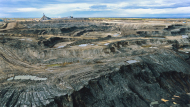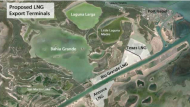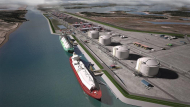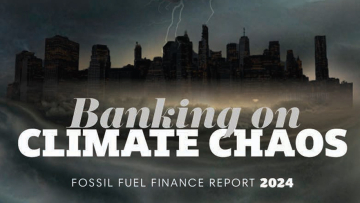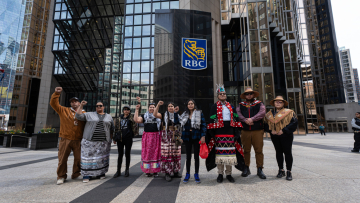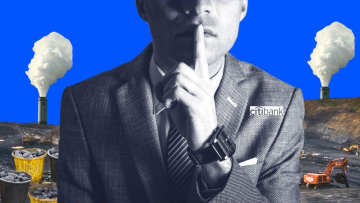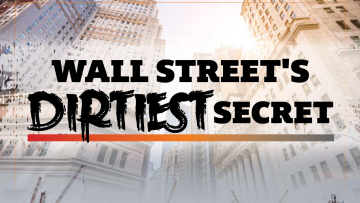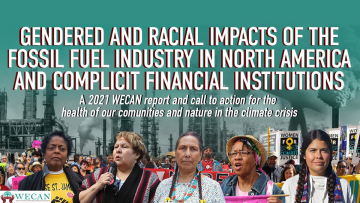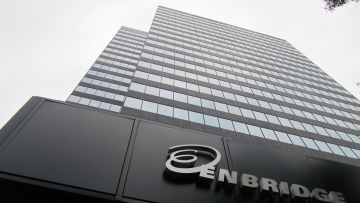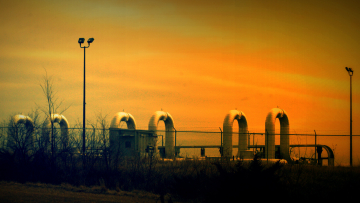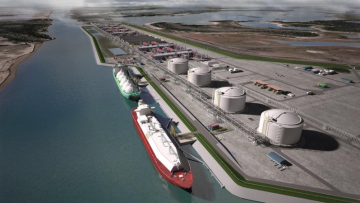
Company – On record
This profile is no longer actively maintained, with the information now possibly out of date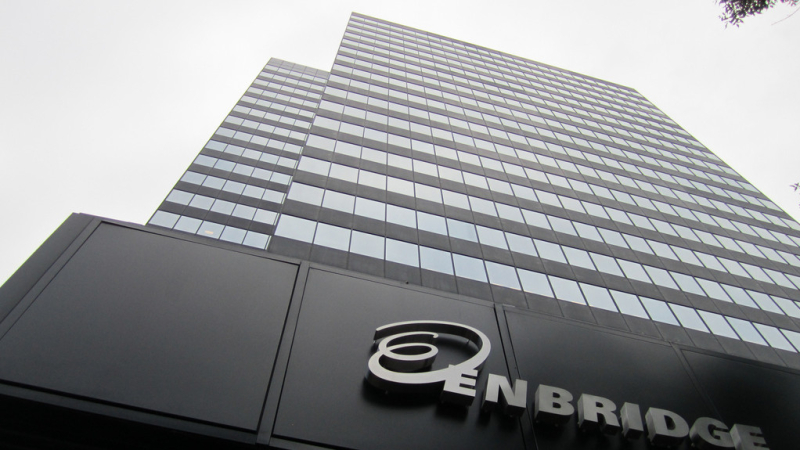
Company – On record
This profile is no longer actively maintained, with the information now possibly out of dateWhy this profile?
Enbridge is a Canadian energy company mainly involved in gas and crude oil distribution. It owns 38,375 kilometers of gas pipelines in 30 U.S. states, five Canadian provinces and offshore in the Gulf of Mexico. In addition, it operates 27,564 kilometres of oil pipelines and has expanded its pipeline capacity with its Line 3 Replacement Project, which is completely incompatible with the goals of the Paris Agreement. With a long history of oil spills from its pipelines, Enbridge is responsible for severe environmental pollution in North America.
| Sectors | Pipeline Transportation of Crude Oil , Oil and Gas Extraction, Pipeline Transportation of Natural Gas |
| Headquarters |
|
| Ownership |
listed on NYSE & Toronto Stock Exchange
Enbridge's shareholder structure can be accessed here. Royal Bank of Canada is the largest shareholder with 15.3%. |
| Subsidiaries |
Enbridge Energy Partners – United States
|
| Website | http://www.enbridge.com |
Enbridge is a Canadian multinational energy transportation company based in Calgary, Alberta. It was originally incorporated by Imperial Oil in 1949 as the Interprovincial Pipeline Company (IPL). IPL Energy became Enbridge in 1998. Enbridge focuses on the transportation, distribution and generation of energy, primarily in North America. As a transporter of energy, Enbridge has operations in Canada and the United States. The company owns the longest crude oil and liquid hydrocarbons transportation system in North America. As a distributor of various fuels, it owns and operates Canada's largest natural gas distribution network. In Sept 2018 Enbridge bought Spectra Energy, a US oil and gas pipeline company. Other subsidiaries are Enbridge Energy Partners and Westcoast Energy.
Impact on human rights and communities
Indigenous Peoples Rights Enbridge's Line 3 pipeline threatens the cultural survival of the Ojibwe Indigenous People. The route would pierce the heart of the 1855 Treaty territory, where the members of Ojibwe bands retain their rights to hunt, fish, harvest wild rice, conduct religious ceremonies and travel. Wild rice lies at the core of Ojibwe identity and culture. Because of its key cultural role, wild rice harvesting is explicitly defined as a right in the treaties of several bands of Ojibwe with the U.S. Government. The Line 3 pipeline would send nearly one million barrels of tar sands per day through wild rice beds. The Mille Lacs, Red Lake and White Earth Nations bands have not given their Free, Prior and Informed Consent to the Line 3 Pipeline project (for more information see here).
Impact on climate
Canada’s far North is experiencing rapid climate change. Rising temperatures will cause severe sea level rise, jeopardising seaside communities. Scientists predict that extreme weather events will become more frequent, causing both droughts and floods across the country.
Enbridge maintains the longest oil pipeline network in the world, which stretches across North America. The company transports more than 30% of the crude oil produced in North America and manages up to 40% of all crude imported to the United States. According to the company’s 2021 sustainability report, the gas Enbridge sells to consumers adds up to almost 50 million tonnes of carbon dioxide equivalent.
Enbridge’s scope 3 emissions make up almost 70% of the company’s entire carbon footprint. To reduce its exposure to crude oil, Enbridge began investing in gas, hydrogen, and carbon capture and storage technologies - none of which adequately reduce its emissions. Enbridge’s renewable energy portfolio makes up less than five percent of its annual earnings, and the company has no plans to make renewables a central part of its strategy going forward.
Impact on nature and environment
Tar sands Tar sands are a type of highly polluting unconventional fossil fuel. Most of the world’s proven tar sands reserves are in the province of Alberta, Canada. Surface mining of tar sands involves clearing large sections of boreal forest. The tar sands extraction and refining process also puts a heavy burden on fresh water supplies, consuming about six units of water for each unit of tar sands gasoline produced. The resulting waste water is highly toxic and often ends up stored in dangerous ‘tailings ponds’. Due to these unconventional extraction and refining methods, Canadian tar sands emit about 31% more greenhouse gases over their entire life cycle than average North American crude. The extraction of tar sands, and its transport by pipelines, is also linked to many other environmental and human rights issues such as water pollution, increased rates of cancer, disruption of habitat, air pollution and disruption, and violations of the collective human rights of Indigenous People. They have been called the most destructive industrial projects in human history.
Enbridge's pipelines facilitate the continued extistence of tar sands in Alberta, Canada, since these projects require pipelines to be financially viable.
Line 3 pipeline replacement project Enbridge began construction in December 2020, despite COVID risks, legal challenges and sustained Indigenous-led opposition. This project is an environmental catastrophe: the construction would add 193 million tons of GHG to the atmosphere annually, annual emissions that are equivalent to 50 new coal plants. According to Honor The Earth, it also violates the treaty rights of the Anishinaabeg by endangering critical natural and cultural resources. Ironically, Enbridge’s ESG goals include contributing “to Indigenous reconciliation through employment strategies and training”.
Spills In the period of 2010 - 2016 Enbridge and its subsidiaries and joint ventures had 147 spills totaling 40,794 barrels of hazardous liquids. Of those spills 137 were crude oil, 7 were refined petroleum products and 3 were High Volatile Liquids (HVL). Around half of Enbridge’s total comes from a catastrophic 20,082 barrel diluted bitumen spill into Michigan’s Kalamazoo River in 2010. In total, Enbridge saw 17 significant spills during this time period, all crude oil spills. Enbridge and its subsidiaries and joint ventures currently operate 66,000 kilometres of oil and gas pipelines in North America.
Spills into Kalamazoo River In July 2010, Enbridge’s Line 6B pipeline ruptured, spilling over 20,000 barrels of diluted bitumen into the Kalamazoo River near the town of Marshall, Michigan. The spill impacted hundreds of families, polluted 36 miles of river, and only narrowly avoided contaminating Lake Michigan. The spilled bitumen sunk to the bottom of the river triggering a years-long, billion dollar clean-up operation that required dredging the river bottom. Even today the river and its surrounding still show the impact of the spill.
In 2022 12 banks financed Enbridge via lending and underwriting totalling USD 11.120 billion. See below for more details on banks involved.
On February 10th 2021, Enbridge renewed its USD 1.0 billion sustainability linked credit facility (maturing in July 2025) with CIBC, Scotiabank, Bank of Montreal, RBC and TD Bank. These financial institutions are also the five biggest financiers of Enbridge: from 2016 to 2021 they dedicated USD 60.08 billion to the company – including USD 10.87 billion in 2021 alone. (BOCC report 2022).
As of 31 December 2021, Enbridge's credit facilities amount to CAD 6.5 billion (2021 Annual Report, page 75).
On 6 July 2020, Enbridge issued a USD 1 billion bond due 2080. Arrangers: JP Morgan, Barclays, Citigroup, Credit Suisse, Sumitomo Mitsui Banking Corp, Mizuho Bank, MUFG Bank. (IJGlobal).
On 20 February 2020, Enbridge issued a USD 750 million bonds, due 1 February 2022. Bond arrangers were JP Morgan and Bank of America Merrill Lynch. The proceeds will be used for the refinancing of existing debt and energy operations. (IJGlobal).
Based on Enbridge's annual reports, other outstanding loans include:
- USD 210 million to Enbridge Energy Partners, maturing Sept 26 2022, led by Bank of America, Mizuho, Royal Bank of Canada;
-
A July 18, 2019 non-revolving bilateral credit facility for CAD 500 million with an Asian bank.
-
A May 16, 2019 non-revolving credit facility for CAD 641 million to Enbridge Inc with a syndicate of Japanese banks, likely MUFG, Mizuho and SMBC.
Specific banks involved are listed below.
Applicable norms and standards
Canada's Tar Sands: The most destructive project on Earth? - Truthloader
2022
2022-06-17 00:00:00 | Enbridge continues to threaten a fifth of the world’s fresh water
The enbridge corporation continues to operate its dangerous Line 5 pipeline in direct violation of the first-ever shutdown order for an existing pipeline. Each day Enbridge continues to operate Line 5, it poses a threat to one-fifth of the world’s fresh water (Read more here: National Observer Canada).
2020
2020-11-09 00:00:00 | Enbridge gets mixed reviews after setting 2050 net-zero target
Enbridge Inc. is getting mixed reviews after becoming the biggest fossil in North America to set sights on net-zero greenhouse gas emissions by 2050, beginning with a 2030 target to reduce the emissions intensity of its operations by 35%. Greenpeace Canada Senior Energy Strategist Keith Stewart said Enbridge’s announcement read more like marketing than real progress. “Investors want to see real decarbonization plans, and until Enbridge accepts the challenge of becoming a 100% renewable energy company, this is simply greenwashing,” he told the Globe. “Using solar energy to power the pumps that push oil and gas through your pipelines can’t hide the fact that you’re still selling fossil fuels.” (The Energy Mix)
2020-02-13 00:00:00 | Enbridge buys NextDecade's Rio Bravo Pipeline
Enbridge entered into a definitive agreement on Feb. 13, 2020 whereby Enbridge would acquire Rio Bravo Pipeline Company, LLC (RBPL) from NextDecade for a cash purchase price not to exceed $25 million, with $15 million paid at closing and the balance paid upon NextDecade’s reaching a positive final investment decision (FID) on its Rio Grande LNG export facility in the Port of Brownsville, Texas. The Rio Bravo Pipeline Project is designed to transport up to 4.5 billion cubic feet per day of natural gas from the Agua Dulce supply area to NextDecade's Rio Grande LNG project in Brownsville, Texas. (Enbridge)

